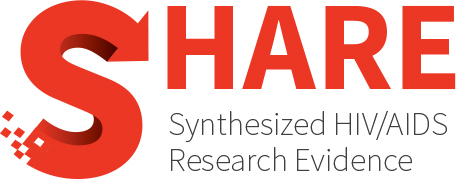Category Archives: Prevention, Engagement and Care Cascade
Isoniazid preventive therapy for prevention of tuberculosis among people living with HIV in ethiopia: A systematic review of implementation and impacts
BACKGROUND: Tuberculosis (TB) is a major cause of morbidity and mortality in people living with HIV (PLWHIV). Isoniazid preventive therapy (IPT) prevents TB in PLWHIV, but estimates of its effects...
Exploring the role of empowerment in Black women’s HIV and AIDS activism in the United States: An integrative literature review
Black women in the United States continue to be disproportionately affected by the Human Immunodeficiency Virus (HIV)/Acquired Immunodeficiency Syndrome (AIDS) epidemic. HIV/AIDS activism among Black women for Black women may...
The impacts of COVID-19 pandemic on service delivery and treatment outcomes in people living with HIV: A systematic review
INTRODUCTION: The COVID-19 epidemic and various control and mitigation measures to combat the widespread outbreak of the disease may affect other parts of health care systems. There is a concern...
A review of factors associated with methadone maintenance treatment adherence and retention in Vietnam
BACKGROUND: Starting in 2008, Vietnam’s national MMT program expanded quickly, but it is struggling with increasing attrition rates and poor adherence among patients. Several studies have reported on MMT retention...
Associations between the prevalence of chronic hepatitis B among people who inject drugs and country-level characteristics: An ecological analysis
Introduction: Globally, hepatitis B virus (HBV) is a leading cause of liver disease. People who inject drugs (PWID) are at greater risk than the general population of contracting HBV. This risk...
Prevalence of sexualized drug use and risk of HIV among sexually active MSM in East and South Asian countries: Systematic review and meta-analysis
Introduction: Sexualized drug use (SDU), the use of psychoactive drugs in the context of sexual intercourse, has been identified as a risk factor for HIV among men who have sex with...
Interventions to increase the uptake and continuation of pre-exposure prophylaxis (PrEP) by adolescent girls and young women at high risk of HIV in low-income and middle-income countries: A scoping review
INTRODUCTION: Effective strategies to increase pre-exposure prophylaxis (PrEP) uptake and continuation among adolescent girls and young women (AGYW) who engage in sex work or transactional sex are sparsely reported. We...
Integrating pre-exposure prophylaxis of HIV infection into family planning services: A scoping review
INTRODUCTION: The aim of this review was to map evidence of integrating pre-exposure prophylaxis (PrEP) for HIV prevention into family planning services. A comprehensive package, using a combination of PrEP...
Determining the screening frequency for sexually transmitted infections for people who use HIV pre-exposure prophylaxis: A systematic review and meta-analysis
Background: Although the World Health Organization (WHO) recommends ‘frequent’ screening of sexually transmitted infections (STI) for people who use pre-exposure prophylaxis (PrEP) for HIV, there is no evidence for optimal frequency....
A scoping review on COVID-19 vaccine hesitancy among the lesbian, gay, bisexual, transgender, queer, intersex and asexual (LGBTQIA+) community and factors fostering its refusal
BACKGROUND: The ramifications of the existing crisis caused by the coronavirus pandemic are sensed in all walks of life. Among the various efforts made to curb the spread of this...
Mental health problems across the HIV care continuum for adolescents living with HIV in sub-Saharan Africa: A scoping review
Mental health problems (e.g., anxiety, depression) are frequently experienced by adolescents living with HIV (ALWH) and can worsen HIV-related outcomes. This scoping review synthesizes the existing research on ALWHs’ mental...
